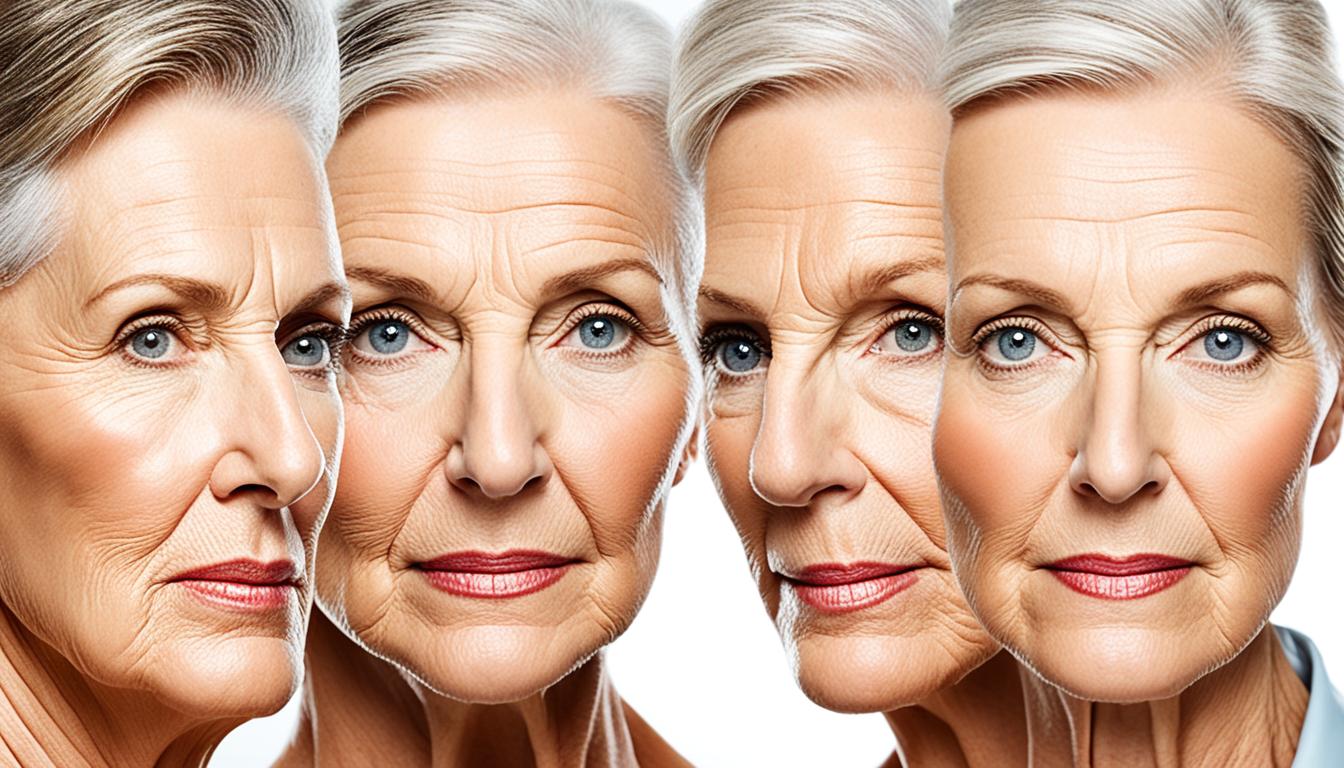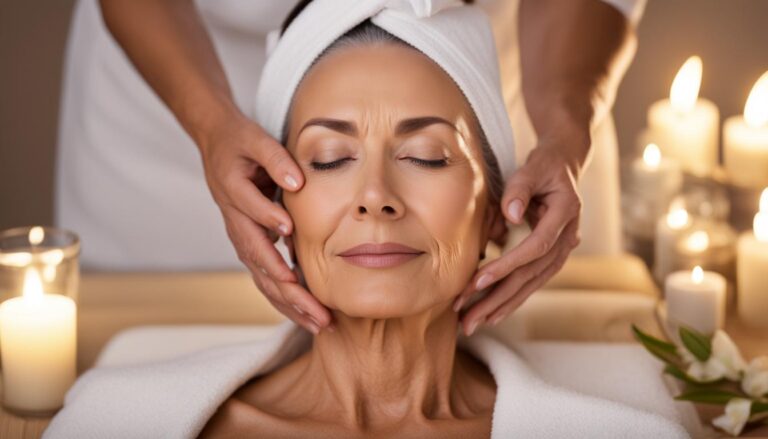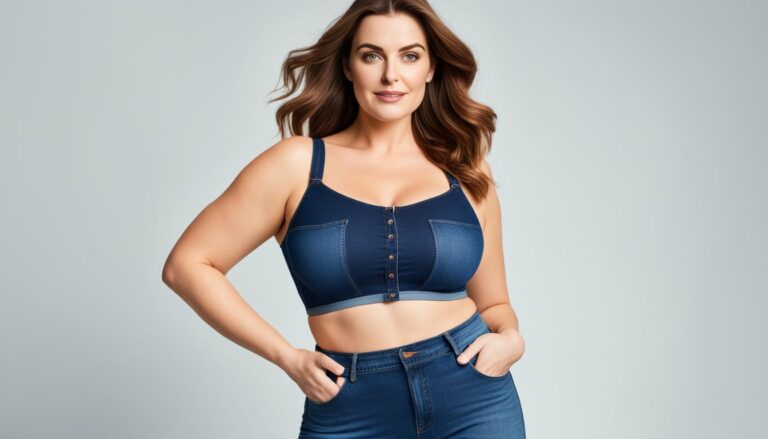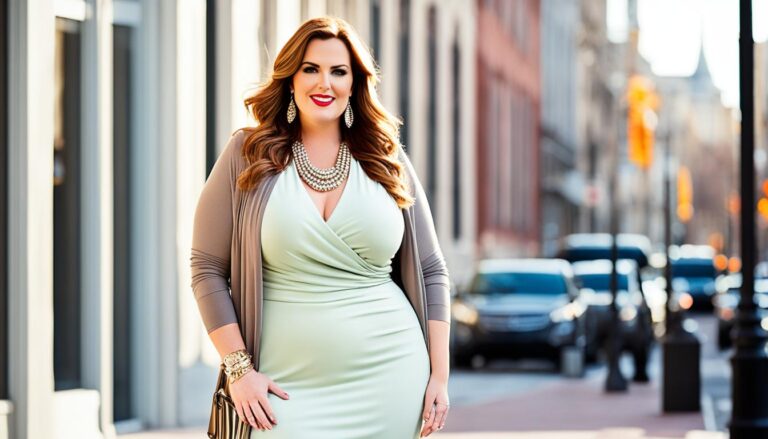What skin looks like at 50?
Have you ever wondered how your skin will change as you age? What will it look like when you reach your 50s? Will it still be as vibrant and youthful as it is now? Or will the signs of aging start to show? One thing is for certain, our skin undergoes a natural aging process that can significantly impact its appearance and texture. But what exactly are these changes? And how can we maintain youthful-looking skin even in our 50s? Prepare to uncover the truth about skin at 50 and discover the secrets to maintaining a radiant complexion throughout the aging process.
Key Takeaways:
- As we age, our skin undergoes various changes, including loss of elasticity, volume, fine lines, and discoloration.
- Adapting skincare routines to meet the changing needs of the skin is essential to maintain a youthful appearance.
- Each decade of life requires different skincare concerns and treatments to address the signs of aging.
- There are effective skincare options available to combat the effects of aging, such as dermal fillers, laser therapy, and hydrating products.
- Embracing the natural changes that come with age and prioritizing self-care is key to maintaining confidence and a positive mindset.
Skincare in Your 20s
In your 20s, it’s essential to establish a proper skincare routine to address the specific concerns of this age. By taking preventive measures and incorporating key skincare products, you can maintain a healthy complexion and set a foundation for future skin health.
To start, daily sun protection is crucial. Protecting your skin from harmful UV rays helps prevent sun damage, premature aging, and reduces the risk of skin cancer. Make sunscreen with a high SPF a non-negotiable part of your morning skincare routine.
Additionally, addressing slight dullness and tired-looking skin is important. To combat these concerns, consider incorporating AHA/BHA-based serums into your routine. These serums contain alpha-hydroxy acids (AHA) and beta-hydroxy acids (BHA) which gently exfoliate the skin, promoting a radiant complexion and improving skin texture.
Another powerful ingredient to consider in your 20s is topical retinol. Retinol aids in cell turnover and collagen production, helping to minimize the appearance of fine lines and prevent early signs of aging. Start with a low concentration of retinol and gradually build up as your skin adjusts.
Skincare Routine in Your 20s:
- Use a gentle cleanser twice a day to remove dirt, oil, and impurities.
- Apply a lightweight moisturizer to keep your skin hydrated without feeling heavy or greasy.
- Integrate an AHA/BHA-based serum into your nighttime routine to address dullness and promote gentle exfoliation.
- In the morning, apply sunscreen with at least SPF 30 to shield your skin from harmful UV rays.
- Consider using a topical retinol product at night to support collagen production.
Remember, prevention and consistency are key. By establishing a skincare routine that includes sun protection, AHA/BHA-based serums, and topical retinol, you can take proactive steps to optimize and maintain the health and appearance of your skin in your 20s.
Skincare in Your 30s
In your 30s, you may start noticing the early signs of aging, such as fine lines, loss of volume in your cheeks, pigmentation issues, and a decrease in collagen production. It’s important to adopt a skincare routine that addresses these concerns and nourishes your skin for a healthy glow.
To combat fine lines and wrinkles, consider incorporating antioxidants into your skincare regimen. Antioxidants help repair sun damage and protect your skin from external aggressors. Look for products containing ingredients like vitamin C, vitamin E, and green tea extract.
Loss of volume in the cheeks is a common issue in your 30s. You can address this concern by using products with hyaluronic acid, which helps hydrate and plump the skin. Additionally, dermal fillers can provide an instant lift and restore volume to your cheeks, giving you a more youthful appearance.
Pigmentation issues, such as dark spots or uneven skin tone, can be managed with the help of targeted treatments. Consider incorporating products with ingredients like niacinamide, kojic acid, or hydroquinone into your routine. Laser therapy, such as IPL or Photofacials, can also be effective in reducing pigmentation and improving overall skin tone.
Laser Therapy and Injectables
“IPL and Photofacials can effectively treat pigmentation issues in your 30s while minimizing downtime.” – Dr. Emily Johnson, Dermatologist
Laser therapy, such as IPL (Intense Pulsed Light) or Photofacials, can target various skin concerns, including pigmentation, fine lines, and even mild acne scars. These procedures use light energy to stimulate collagen production, resulting in a rejuvenated and glowing complexion.
Injectables, such as Botox and dermal fillers, are also popular options for addressing prominent lines and wrinkles in your 30s. Botox can help relax the muscles that cause dynamic wrinkles, while dermal fillers restore lost volume and smooth out deeper lines.
Skincare Tips for Your 30s
- Use a broad-spectrum sunscreen with at least SPF 30 daily to protect your skin from harmful UV rays.
- Invest in a good eye cream that targets fine lines, puffiness, and dark circles.
- Exfoliate regularly to promote cell turnover and maintain a youthful glow. Look for gentle exfoliators with AHA or BHA acids.
- Hydrate your skin with a moisturizer that suits your skin type and contains ingredients like hyaluronic acid.
- Adopt a healthy lifestyle with a balanced diet, regular exercise, and adequate sleep to support overall skin health.
Summary
In your 30s, it’s crucial to address the signs of aging, such as fine lines, loss of volume, and pigmentation issues. Incorporating antioxidants into your skincare routine, considering laser therapy and injectables, and following a comprehensive skincare regimen can help you maintain a youthful complexion. By taking care of your skin in your 30s, you’re setting the foundation for healthy and radiant skin as you age.
Skincare in Your 40s
In your 40s, the firmness of your skin becomes a major concern due to the loss of volume and elasticity. As you age, natural factors such as a decrease in collagen and elastin production contribute to the formation of wrinkles. Additionally, sun damage accumulated over years can further accelerate these signs of aging.
To combat these changes, incorporating the right skincare routine and treatments is crucial. There are various options available to address the specific needs of your skin in your 40s.
Treatments for Firmness and Wrinkles
If you’re looking to restore firmness and reduce the appearance of wrinkles, considering fillers and chemical peels can be beneficial.
- Fillers: Injectable fillers, such as hyaluronic acid-based dermal fillers, can help replenish lost volume and restore a more youthful appearance to your skin. These fillers can be administered by a dermatologist or a trained professional to target specific areas, such as nasolabial folds or marionette lines.
- Chemical Peels: Chemical peels involve the application of a chemical solution to exfoliate and rejuvenate the skin. They help improve the texture, tone, and appearance of the skin, reducing the visibility of fine lines and wrinkles.
These treatments can provide noticeable results, but it’s essential to consult with a skincare professional to determine the most suitable options for your specific concerns.
Skincare Routine for Skin Barrier Repair
In addition to professional treatments, it’s crucial to establish a consistent skincare routine to maintain the health of your skin barrier and address other age-related issues.
Focus on repairing and nourishing your skin barrier by incorporating products that contain hyaluronic acid, glycerin, ceramides, and fatty lipids. These ingredients help to hydrate your skin, retain moisture, and strengthen the protective barrier function.
Consider using a moisturizer specifically formulated for mature skin to provide intensive hydration and promote a plumper, more youthful complexion. Look for products that are rich in antioxidants to combat free radicals and reduce oxidative stress caused by environmental factors.
Don’t forget to include SPF in your daily skincare routine to protect your skin from further sun damage, as the harmful effects of the sun can exacerbate the signs of aging.
Avoiding Common Skincare Mistakes
“Taking care of your skin in your 40s requires diligence and knowledge about the best practices. Avoid common skincare mistakes to ensure you’re providing your skin with the care it needs.”
Here are a few common mistakes to steer clear of:
- Skipping sunscreen: Sun damage is a major contributor to premature aging. Always wear broad-spectrum sunscreen with at least SPF 30, even on cloudy days.
- Overusing harsh products: Avoid using aggressive exfoliants or cleansers that can strip the skin of its natural oils and disrupt the moisture balance.
- Neglecting the neck and décolletage: Extend your skincare routine beyond your face and include the neck and décolletage areas to maintain a consistent appearance.
By actively addressing these mistakes and following a well-rounded skincare routine, you can better maintain the firmness, volume, and overall health of your skin in your 40s.
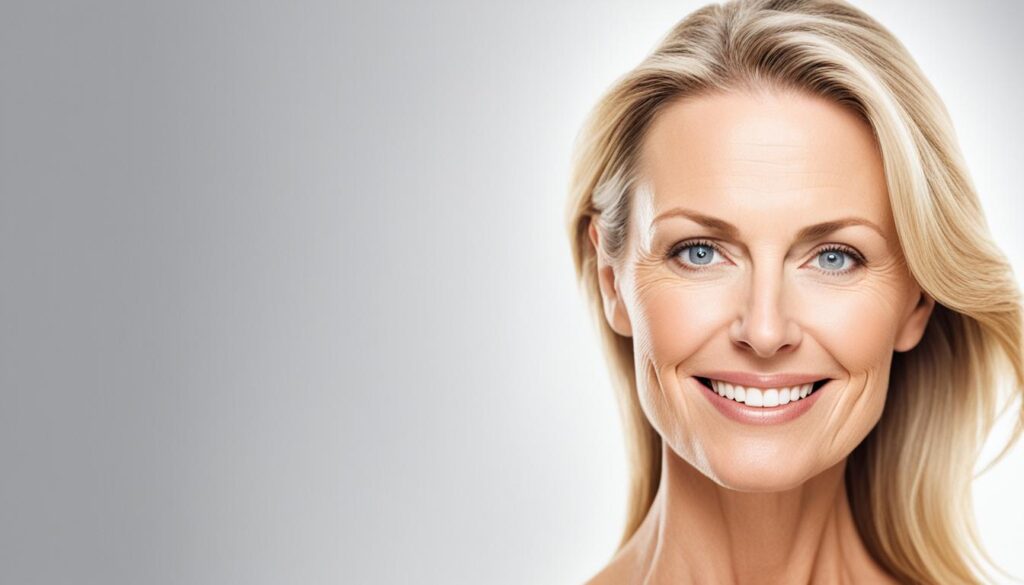
| Treatments | Benefits |
|---|---|
| Fillers | Restores lost volume Reduces the appearance of wrinkles |
| Chemical Peels | Exfoliates and rejuvenates the skin Improves texture and tone Reduces fine lines and wrinkles |
What Skin Looks Like at 50
In your 50s, the effects of aging become more pronounced. Skin laxity, sagging, and deeper wrinkles are common signs of aging in your 50s. As the collagen and elastin fibers in your skin weaken, you may experience a loss of firmness and elasticity. This can lead to the appearance of loose skin, especially in areas such as the face, neck, and jawline.
To combat skin laxity and achieve a more youthful appearance, many individuals turn to cosmetic treatments such as Dermal Fillers and Thermage FLX. Dermal Fillers are injectable treatments that can restore volume to your skin, improving the appearance of sagging and filling in deep wrinkles. Thermage FLX is a non-invasive procedure that uses radiofrequency technology to tighten and tone loose skin. These treatments can help you achieve a smoother, more lifted look.
Aside from skin laxity, other common skin concerns in your 50s include dryness, thinning skin, and increased sensitivity. As the skin’s natural moisture levels diminish, it can become prone to dryness and irritation. To combat these issues, it’s important to incorporate hydrating products into your skincare routine. Look for moisturizers and serums that contain ingredients like hyaluronic acid and peptides, which can help replenish moisture and improve the appearance of fine lines and wrinkles.
Remember to protect your skin from further damage by wearing sunscreen daily and avoiding prolonged sun exposure. The sun’s harmful UV rays can accelerate the aging process and exacerbate skin concerns such as dryness and thinning. Using a broad-spectrum sunscreen with an SPF of 30 or higher can help protect your skin from UV damage.
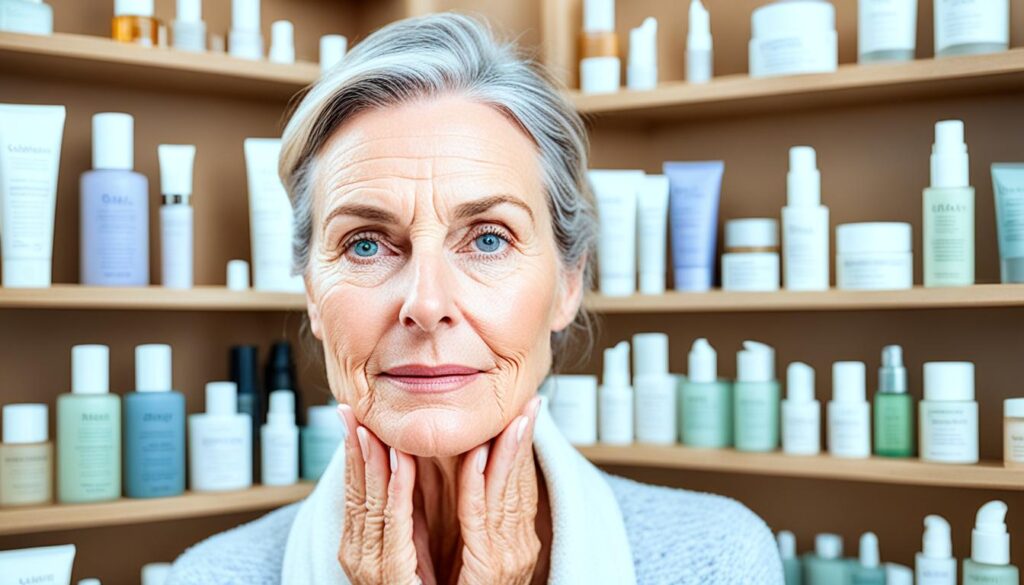
Overall, taking care of your skin in your 50s involves addressing signs of aging such as skin laxity, sagging, and wrinkles. By incorporating treatments like Dermal Fillers and Thermage FLX, along with hydrating products and sun protection, you can maintain a healthy and youthful-looking complexion.
Treatment Options for Loose or Sagging Skin
When it comes to addressing loose or sagging skin in your 50s, there are various treatment options available. These treatments can help tighten and rejuvenate your skin, giving you a more youthful appearance. Here are some popular options to consider:
Dermal Fillers
Dermal Fillers are a common choice for treating loose or sagging skin. These injectable fillers can restore volume to your face, helping to lift and plump the skin. They are particularly effective in the mid-face area, where skin tightness is often a concern.
Radiofrequency Therapy
Radiofrequency therapy is a non-invasive technique that uses radiofrequency energy to heat the deeper layers of the skin. This heat encourages collagen production, which in turn helps to tighten the skin and improve its elasticity. It is a popular choice for skin tightening and can be used on various areas of the body.
Laser Procedures
Lasers can also be used to address loose or sagging skin. Laser treatments stimulate collagen production and can target specific areas to tighten and firm the skin. There are different types of laser treatments available, such as Picosure and Morpheus 8, which offer precise and effective results.
Collagen-Stimulating Procedures
Procedures that stimulate collagen production are another option for addressing loose or sagging skin. Ulthera is a non-invasive procedure that uses ultrasound energy to lift and tighten the skin. It stimulates collagen production, resulting in improved skin elasticity. Vampire Facials, also known as Platelet-Rich Plasma (PRP) therapy, utilize your own blood plasma to stimulate collagen growth, promoting tighter and firmer skin.
Here is a table summarizing these treatment options:
| Treatment | Description |
|---|---|
| Dermal Fillers | Injectable fillers to restore volume and lift sagging skin. |
| Radiofrequency Therapy | Non-invasive treatment that uses radiofrequency energy to heat the skin and stimulate collagen production. |
| Laser Procedures | Various laser treatments that target specific areas to tighten and firm the skin. |
| Collagen-Stimulating Procedures | Procedures that stimulate collagen production, such as Ulthera and Vampire Facials. |
It’s important to consult with a qualified dermatologist or cosmetic surgeon to determine the most suitable treatment option for your specific needs. They will be able to assess your skin condition and recommend the best course of action to achieve your desired results.
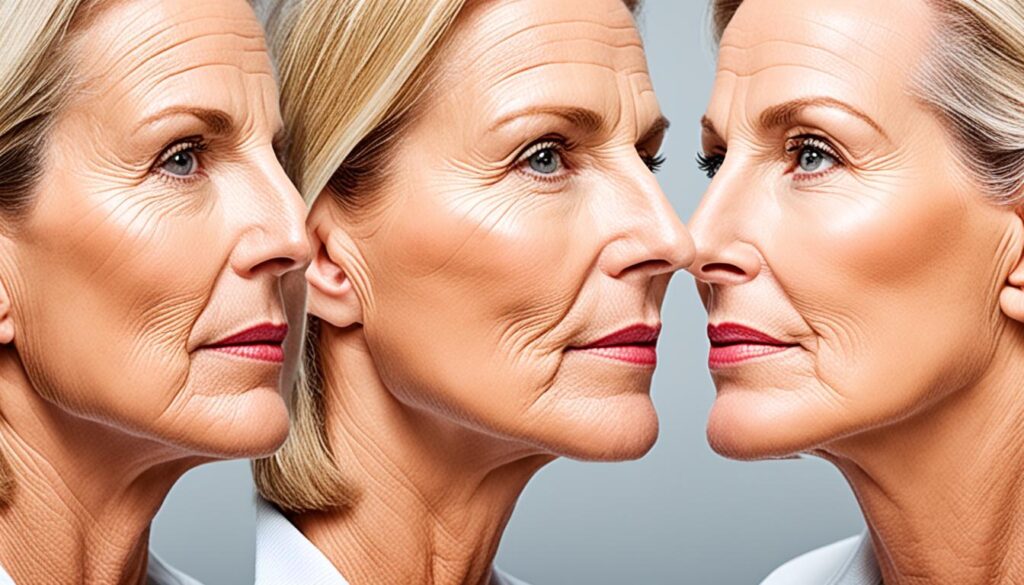
With advancements in cosmetic procedures, you have a range of options to address loose or sagging skin. Whether you choose dermal fillers, radiofrequency therapy, laser procedures, or collagen-stimulating treatments, these interventions can help you achieve a more youthful and rejuvenated appearance.
Addressing Dryness, Thinning, and Sensitivity
Dry skin, along with thinning and increased sensitivity, are common skin concerns that often arise in your 50s. These changes can be attributed to a decrease in natural oil production and a slowdown in cell turnover. To combat these issues and maintain healthy and hydrated skin, it’s important to incorporate specific skincare products and practices into your routine.
Hydrating Products
One essential step in addressing dryness is to use hydrating skincare products that provide intense moisture to your skin. Look for products that contain hyaluronic acid, a powerful humectant that attracts and retains moisture. Hyaluronic acid helps to plump the skin and reduce the appearance of fine lines and wrinkles. Another beneficial ingredient to look for is peptides, which help to enhance hydration and support collagen production.
Nourishing Moisturizer
When choosing a moisturizer for dry skin in your 50s, opt for nourishing formulas that are rich in emollients and occlusives. Emollients such as shea butter and ceramides help to replenish and repair the skin’s barrier, preventing moisture loss. Occlusives like petrolatum or dimethicone form a protective layer on the skin, sealing in hydration. Consider using a nourishing moisturizer both morning and night to keep your skin hydrated throughout the day.
Face Masks
Face masks can provide an extra boost of hydration to your skin. Look for masks that contain ingredients like hyaluronic acid, glycerin, or aloe vera, which have moisturizing and soothing properties. Apply a hydrating face mask once or twice a week to help replenish moisture and improve the overall appearance of your skin.
Cosmeceutical Products with AHA/BHA Acids
Cosmeceutical products that contain alpha hydroxy acids (AHAs) and beta hydroxy acids (BHAs) can be beneficial for addressing dryness, thinning, and sensitivity. AHAs, such as glycolic acid, help to exfoliate the skin, remove dead cells, and promote cell turnover. BHAs, like salicylic acid, have anti-inflammatory properties that can help soothe and calm sensitive skin. However, it’s important to use these products carefully and as directed, as overuse can lead to further damage to the skin barrier.
By incorporating hydrating products, nourishing moisturizers, and face masks into your skincare routine, you can address the dryness, thinning, and sensitivity often experienced in your 50s. Additionally, cosmeceutical products containing AHA/BHA acids can help improve the overall condition of your skin. Remember to choose products that are suitable for your skin type and concerns, and always consult with a dermatologist if you have any specific skin issues or sensitivities.
Prevention and Self-Care
When it comes to maintaining healthy skin at 50, prevention and self-care are key. By incorporating a few essential steps into your daily routine, you can protect and nourish your skin for a youthful appearance. Let’s explore some effective strategies:
1. Sun Protection
Regularly applying sunscreen is crucial at any age, but it becomes even more important in your 50s. Protect your skin from harmful UV rays by using a broad-spectrum sunscreen with at least SPF 30. Apply it generously to all exposed areas, including your face, neck, arms, and hands.
2. Antioxidant-Packed Vitamin C Serum
Vitamin C is a powerful antioxidant that helps fight free radicals and brighten the skin. Incorporate a daily Vitamin C serum into your skincare routine to promote collagen production, reduce hyperpigmentation, and improve overall skin tone.
3. Embrace Retinoids
Retinoids, such as retinol, are highly effective in reducing the appearance of fine lines and wrinkles. Incorporate a retinoid-based product into your nighttime routine to improve skin texture and stimulate collagen production. Start with a low concentration and gradually increase as your skin adjusts.
4. Moisturize and Hydrate
Keeping your skin moisturized is essential for maintaining its elasticity and suppleness. Use a nourishing moisturizer that suits your skin type, and apply it both day and night. Additionally, hydrate your skin from within by drinking an adequate amount of water throughout the day.
5. Follow a Healthy Diet
Eating a well-balanced diet plays a significant role in the health and appearance of your skin. Include foods rich in antioxidants, vitamins, and minerals to nourish your skin from the inside out. Incorporate good fats, such as avocados and nuts, which provide essential nutrients for skin health.
6. Hydrate Your Skin
Hydration is essential for maintaining healthy skin. Use a hydrating face mask or incorporate hyaluronic acid serums into your skincare routine to boost moisture levels and plump up the skin.
Remember, prevention is easier than correction. By following these self-care steps, you can maintain the health and beauty of your skin as you age gracefully.
Treatments for Aging Skin in Your 60s and Beyond
In your 60s and beyond, it’s essential to focus on anti-aging treatments that prioritize hydration and collagen production. These treatments can help maintain a youthful appearance and promote overall skin health. Additionally, adopting a healthy diet that includes raw vegetables and keeping your metabolism active can provide further benefits to your aging skin.
When it comes to rejuvenating your skin in your 60s and beyond, there are several effective treatments to consider:
- Injectables: Injectable treatments such as Botox and dermal fillers can help minimize the appearance of fine lines, wrinkles, and sagging skin. These non-surgical procedures can provide immediate and noticeable results, helping to restore volume and smooth out facial contours.
- Laser procedures: Laser treatments can target various skin concerns like age spots, uneven texture, and skin laxity. Procedures like laser resurfacing or fractional laser therapy stimulate collagen production, improving skin tone and texture.
- Skin-boosting treatments: Skin-boosting treatments, such as microneedling or platelet-rich plasma (PRP) therapy, stimulate collagen production and enhance the skin’s natural rejuvenation process. These procedures can improve skin texture, promote a more youthful appearance, and reduce the visibility of fine lines and wrinkles.
In addition to these treatments, adopting a healthy lifestyle can significantly contribute to the overall health and appearance of your skin. Here are some beneficial practices:
- Hydration: Drink plenty of water to keep your skin hydrated and promote a healthy complexion.
- Collagen-boosting diet: Incorporate foods rich in collagen-building nutrients, such as raw vegetables, fruits, lean proteins, and healthy fats, into your diet. These nutrients can support collagen production and improve skin elasticity.
- Active metabolism: Engage in regular physical activity to keep your metabolism active. Exercise promotes blood circulation, which can help deliver essential nutrients to the skin and support its overall health.
By combining these treatments and lifestyle practices, you can maintain a vibrant and radiant complexion in your 60s and beyond.
Embracing Aging and Personal Choice
Embracing the natural changes of aging is a personal choice. Society often places pressure to fight aging, but it’s important to consider your personal preferences and embrace the unique features that come with age.
Skincare should be approached with self-care and a focus on overall well-being, rather than solely attempting to mimic youthfulness. Accepting skin changes and embracing wrinkles can lead to a healthier and more positive relationship with your appearance.
Addressing societal expectations is crucial in navigating this journey. Remember that beauty comes in all shapes, sizes, and ages. By prioritizing self-acceptance and self-love, you can confidently showcase your authentic self and inspire others to do the same.
Empowering Words
“Wrinkles should merely indicate where smiles have been.” – Mark Twain
The Power of Choice
You have the power to choose how you want to age and how you want to care for your skin. Understand that no one can dictate what’s best for you. It’s essential to listen to your intuition and make decisions that align with your values and desires.
Self-Care and Well-Being
Embracing aging goes beyond physical appearance. It’s about nurturing your well-being and prioritizing self-care. Engage in activities that bring you joy, practice mindfulness, and surround yourself with positive influences.
Quotes from Influencers
“Age is no barrier. It’s a limitation you put on your mind.” – Jackie Joyner-Kersee
“Love the skin you’re in. It’s the only one you’ll ever have.” – Jamie Lee Curtis
By accepting skin changes and embracing the beauty of wrinkles, you can redefine what it means to age gracefully. Remember, it’s your personal journey, and you have the power to choose how you want to live and age.
| Accepting Skin Changes | Embracing Wrinkles | Addressing Societal Expectations |
|---|---|---|
| Recognize that skin changes are a natural part of the aging process. | View wrinkles as reminders of a life well-lived and experiences cherished. | Challenge societal norms and stereotypes associated with aging. |
| Focus on maintaining healthy skin through proper skincare routines. | Appreciate the uniqueness and character that wrinkles bring to your face. | Encourage representation and diversity in media to redefine beauty standards. |
| Stay informed about skincare treatments and options that can support your skin’s health. | Shift your mindset from fighting aging to embracing and celebrating it. | Surround yourself with a supportive and inclusive community that values all ages. |
Conclusion
Skincare in your 50s requires adjusting to the changes that come with aging. It’s important to address the specific concerns that arise at this milestone age to maintain a youthful appearance and feel confident in your skin.
By following a personalized skincare routine, incorporating suitable treatments, and adopting a positive mindset, you can nourish and protect your skin effectively. Embrace the unique features that come with age and prioritize self-care throughout the aging process.
Remember, maintaining youthful skin at 50 is not about chasing a fountain of youth but rather about embracing the best version of yourself. With the right approach, you can achieve healthy, radiant skin that reflects your inner vitality and confidence.

